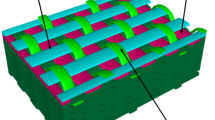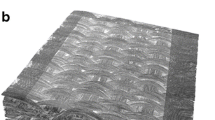Abstract
This paper provides a modeling method for predicting the internal structure of three-dimensional (3D) angle-interlock woven fabric. Inspired by the digital element method, the numerical model of micro-scale was established by using truss element. The numerical model was compared with the Computed Tomography (CT) cross-sectional scan of the actual fabric sample, and the results were consistent. The mechanical properties of the 3D angle-interlock woven fabric is closely related to the fabric’s structure. Therefore, by changing the tension at both ends of the yarn tows to explore the influence on the yarn tows’ geometry, it was found that different tensions affects the cross-sectional areas and crimp angles of the yarn tows. On the basis of fabric forming, multi-shape molds were designed to press the fabric into different shapes, which were semi-hexagonal, arc-shaped and L-shaped. The results of numerical simulation showed that the fabric will undergo inter-layer slip when compressed, especially in the region where the mold deformation is large.
















Similar content being viewed by others
References
Mouritz AP, Cox BN (2010) A mechanistic interpretation of the comparative in-plane mechanical properties of 3D woven, stitched and pinned composites. Compos Appl Sci Manuf 41(6):709–728. https://doi.org/10.1016/j.compositesa.2010.02.001
Chen X, Taylor LW, Tsai LJ (2011) An overview on fabrication of three-dimensional wov-en textile preforms for composites. Text Res J 81(9):932–944. https://doi.org/10.1177/0040517510392471
Bilisik K (2012) Multiaxis three-dimensional weaving for composites: a review. Text Res J 82(7):725–743. https://doi.org/10.1177/0040517511435013
Potluri P, Manan A, Young R, Lei S (2007) Experimental validation of micro-strains pre-dicted by Meso-scale Models for Textile Composites. In: 48th AIAA/ASME/ASCE/AHS/ASC Structures, Structural Dynamics, and Materials Conference. https://doi.org/10.2514/6.2007-2159
Schuster J, Heider D, Sharp K, Glowania M (2008) Thermal conductivities of three-dime-nsionally woven fabric composites. Compos Sci Technol 68(9):2085–2091. https://doi.org/10.1016/j.compscitech.2008.03.024
Shan Z, Chen S, Zhang Q, Qiao J, Wu X, Zhan L (2016) Three-dimensional woven formi-ng technology and equipment. J Compos Mater 50(12):1587–1594. https://doi.org/10.1177/0021998315590267
Renaud J, Vernet N, Ruiz E, Lebel LL (2016) Creep compaction behavior of 3D carbon interlock fabrics with lubrication and temperature. Compos Appl Sci Manuf 86:87–96. https://doi.org/10.1016/j.compositesa.2016.04.017
Behera BK, Dash BP (2015) Mechanical behavior of 3D woven composites. Mater Des 67:261–271. https://doi.org/10.1016/j.matdes.2014.11.020
Yan S, Zeng X, Long A (2019) Meso-scale modelling of 3D woven composite T-joints wi-th weave variations. Compos Sci Technol 171:171–179. https://doi.org/10.1016/j.compscitech.2018.12.024
Gereke T, Döbrich O, Hübner M, Cherif C (2013) Experimental and computational composite textile reinforcement forming: a review. Compos Appl Sci Manuf 46:1–10. https://doi.org/10.1016/j.compositesa.2012.10.004
Naouar N, Vasiukov D, Park CH, Lomov SV, Boisse P (2020) Meso-FE modelling of text-ile composites and X-ray tomography. J Mater Sci 55:16969–16989. https://doi.org/10.1016/j.compscitech.2015.11.023
Vanaerschot A, Cox BN, Lomov SV, Vandepitte D (2016) Experimentally validated stochastic geometry description for textile composite reinforcements. Compos Sci Technol 122:122–129. https://doi.org/10.1016/j.compscitech.2015.11.023
El Said B, Ivanov D, Long AC, Hallet SR (2016) Multi-scale modelling of strongly heterogeneous 3D composite structures using spatial Voronoi tessellation. J Mech Phys Solids 88:50–71. https://doi.org/10.1016/j.jmps.2015.12.024
Miao Y, Zhou E, Wang Y, Cheeseman BA (2008) Mechanics of textile composites: micro-geometry. Compos Sci Technol 68(7–8):1671–1678. https://doi.org/10.1016/j.compscitech.2008.02.018
Nilakantan G (2013) Filament-level modeling of Kevlar KM2 yarns for ballistic impact studies. Compos Struct 104:1–13. https://doi.org/10.1016/j.compstruct.2013.04.001
Samadi R, Robitaille F (2014) Particle-based modeling of the compaction of fiber yarns a-nd woven textiles. Text Res J 84(11):1159–1173. https://doi.org/10.1177/0040517512470200
Sockalingam S, Gillespie JW Jr, Keefe M (2017) Modeling the fiber length-scale respons-e of Kevlar KM2 yarn during transverse impact. Text Res J 87(18):2242–2254. https://doi.org/10.1177/0040517516669074
Grujicic M, Hariharan A, Pandurangan B, Yen CF, Cheeseman BA, Wang Y, Zheng JQ (2012) Fiber-level modeling of dynamic strength of Kevlar® KM2 ballistic fabric. J Mater Eng Perform 21:1107–1119
Wang Y, Sun X (2001) Digital-element simulation of textile processes. Compos Sci Technol 61(2):311–319. https://doi.org/10.1016/S0266-3538(00)00223-2
Zhou G, Sun X, Wang Y (2004) Multi-chain digital element analysis in textile mechanics. Compos Sci Technol 64(2):239–244. https://doi.org/10.1016/S0266-3538(03)00258-6
Döbrich O, Gereke T, Cherif C (2014) Modelling of textile composite reinforcements on the micro-scale. Autex Res J 14(1):28–33. https://doi.org/10.2478/v10304-012-0047-z
Döbrich O, Gereke T, Cherif C (2016) Modeling the mechanical properties of textile-rein-forced composites with a near micro-scale approach. Compos Struct 135:1–7. https://doi.org/10.1016/j.compstruct.2015.09.010
Mahadik Y, Hallett SR (2010) Finite element modelling of tow geometry in 3D woven Fa-Brics. Compos Appl Sci Manuf 41(9):1192–1200. https://doi.org/10.1016/j.compositesa.2010.05.001
Green SD, Long AC, El Said BSF, Hallett SR (2014) Numerical modelling of 3D woven preform deformations. Compos Struct 108:747–756. https://doi.org/10.1016/j.compstruct.2013.10.015
Daelemans L, Faes J, Allaoui S, Hivet G, Dierick M, Van Hoorebeke L, Van Paepegem W (2016) Finite element simulation of the woven geometry and mechanical behaviour of a 3D woven dry fabric under tensile and shear loading using the digital element method. Compos Sci Technol 137:177–187. https://doi.org/10.1016/j.compscitech.2016.11.003
Sockalingam S, Gillespie JW Jr, Keefe M (2014) On the transverse compression response of Kevlar KM2 using fiber-level finite element model. Int J Solids Struct 51(13):2504–2517. https://doi.org/10.1016/j.ijsolstr.2014.03.020
Sockalingam S, Gillespie JW Jr, Keefe M (2017) Role of inelastic transverse compressive behavior and multiaxial loading on the transverse impact of Kevlar KM2 single fiber. Fibers 5(1):9. https://doi.org/10.3390/fib5010009
Sockalingam S, Gillespie JW Jr, Keefe M (2015) Dynamic modeling of Kevlar KM2 sin-gle fiber subjected to transverse impact. Int J Solids Struct 67:297–310. https://doi.org/10.1016/j.ijsolstr.2015.04.031
De Luycker E, Morestin F, Boisse P, Marsal D (2009) Simulation of 3D interlock compos- ite preforming. Compos Struct 88(4):615–623. https://doi.org/10.1016/j.compstruct.2008.06.005
Xiao S, Wang P, Soulat D, Gao H (2020) An exploration of the deformability behaviours dominated by braiding angle during the forming of the triaxial carbon fibre braids. Compos Appl Sci Manuf 133:105890. https://doi.org/10.1016/j.compositesa.2020.105890
Jiao W, Chen L, Xie J, Yang Z (2022) Deformation mechanisms of 3D LTL woven prefor-ms in hemisphere forming tests. Compos Struct 283:115156. https://doi.org/10.1016/j.compstruct.2021.115156
Abtew MA, Boussu F, Bruniaux P, Loghin C, Cristian I, Chen Y, Wang L (2018) Influenc-es of fabric density on mechanical and moulding behaviours of 3D warp interlock para-aramid fabrics for soft body armour application. Compos Struct 204:402–418. https://doi.org/10.1016/j.compstruct.2018.07.101
Durville D (2010) Simulation of the mechanical behaviour of woven fabrics at the scale of fibers. Int J Mater Form 3:1241–1251. https://doi.org/10.1007/s12289-009-0674-7
Acknowledgements
The authors gratefully acknowledge the great support from the National Natural Science Foundation of China (Grant No. 52075498, 11702249, U22A20182).
Author information
Authors and Affiliations
Corresponding authors
Ethics declarations
Competing interests
The authors declare that they have no known competing financial interests or personal relationships that could have appeared to influence the work reported in this paper.
Additional information
Publisher’s Note
Springer Nature remains neutral with regard to jurisdictional claims in published maps and institutional affiliations.
Rights and permissions
Springer Nature or its licensor (e.g. a society or other partner) holds exclusive rights to this article under a publishing agreement with the author(s) or other rightsholder(s); author self-archiving of the accepted manuscript version of this article is solely governed by the terms of such publishing agreement and applicable law.
About this article
Cite this article
Liu, Y., Pan, Z., Yu, J. et al. Numerical simulation of 3D angle-interlock woven fabric forming and compression processes. Int J Mater Form 17, 24 (2024). https://doi.org/10.1007/s12289-024-01824-0
Received:
Accepted:
Published:
DOI: https://doi.org/10.1007/s12289-024-01824-0




